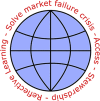To Push or To Pull? In a Post-COVID World, Supporting and Incentivizing Antimicrobial Drug Development Must Become a Governmental Priority
- PMID: 33606496
- PMCID: PMC7931625
- DOI: 10.1021/acsinfecdis.0c00681
To Push or To Pull? In a Post-COVID World, Supporting and Incentivizing Antimicrobial Drug Development Must Become a Governmental Priority
Abstract
The COVID-19 pandemic has refocused attention worldwide on the dangers of infectious diseases, in terms of both global health and the effects on the world economy. Even in high income countries, health systems have been found wanting in dealing with the new infectious agent. However, the even greater long-term danger of antimicrobial resistance in pathogenic bacteria and fungi is still under-appreciated, especially among the general public. Although antimicrobial drug development faces significant scientific challenges, the gravest challenge at the moment appears to be economic, where the lack of a viable market has led to a collapse in drug development pipelines. There is therefore a critical need for governments across the world to further incentivize the development of antimicrobials. Most incentive strategies over the past decade have focused on so-called "push" incentives that bridge the costs of antimicrobial research and development, but these have been insufficient for reviving the pipeline. In this Perspective, we analyze the current incentive strategies in place for antimicrobial drug development, and focus on "pull" incentives, which instead aim to improve revenue generation and thereby resolve the antimicrobial market failure challenge. We further analyze these incentives in a broader "One Health" context and stress the importance of developing and enforcing strict protocols to ensure appropriate manufacturing practices and responsible use. Our analysis reiterates the importance of international cooperation, coordination across antimicrobial research, and sustained funding in tackling this significant global challenge. A failure to invest wisely and continuously to incentivize antimicrobial pipelines will have catastrophic consequences for global health and wellbeing in the years to come.
Keywords: One Health; access; antimicrobial resistance; global health policy; market failure; push and pull incentives.
Conflict of interest statement
The authors declare the following competing financial interest(s): J.C. declares co-ownership/ownership of stock in Siemens India and Tata Consultancy Services, which have branches involved with medical diagnostics. J.C. and C.G.D. also declare a professional research interest in the development of assays for antimicrobial drug discovery and biosensing, which may have commercial applications in the future. J.C. is listed as an inventor on a patent application for a biosensing technology and is likely to be involved with the commercialization of the technology via a spin-out company or other means. C.G.D. is Director of Antimicrobial Discovery Solutions Ltd. and a paid member of the ethics committee for Micropathology Ltd. P.T. is a freelance editor at Elsevier. V.L. is undertaking a year-long placement at Pfizer as part of her studies. A.K. declares that he is a Recruitment Lead at Polygeia, which is a voluntary, unpaid position.
Figures



Similar articles
-
How can the EU support sustainable innovation and access to effective antibiotics? Policy options for existing and new medicines [Internet].Copenhagen (Denmark): European Observatory on Health Systems and Policies; 2023. Copenhagen (Denmark): European Observatory on Health Systems and Policies; 2023. PMID: 37582187 Free Books & Documents. Review.
-
Antimicrobial resistance research in a post-pandemic world: Insights on antimicrobial resistance research in the COVID-19 pandemic.J Glob Antimicrob Resist. 2021 Jun;25:5-7. doi: 10.1016/j.jgar.2021.02.013. Epub 2021 Mar 1. J Glob Antimicrob Resist. 2021. PMID: 33662647 Free PMC article.
-
Pull Incentives for Antibacterial Drug Development: An Analysis by the Transatlantic Task Force on Antimicrobial Resistance.Clin Infect Dis. 2017 Oct 15;65(8):1378-1382. doi: 10.1093/cid/cix526. Clin Infect Dis. 2017. PMID: 29017240
-
A Broken Antibiotic Market: Review of Strategies to Incentivize Drug Development.Open Forum Infect Dis. 2020 Mar 13;7(7):ofaa083. doi: 10.1093/ofid/ofaa083. eCollection 2020 Jul. Open Forum Infect Dis. 2020. PMID: 32667365 Free PMC article.
-
Expanding antibiotic, vaccine, and diagnostics development and access to tackle antimicrobial resistance.Lancet. 2024 Jun 8;403(10443):2534-2550. doi: 10.1016/S0140-6736(24)00878-X. Epub 2024 May 23. Lancet. 2024. PMID: 38797178 Review.
Cited by
-
Global Mapping and Visualization Analysis of One Health Knowledge in the COVID-19 Context.Environ Health Insights. 2024 Mar 5;18:11786302241236017. doi: 10.1177/11786302241236017. eCollection 2024. Environ Health Insights. 2024. PMID: 38449589 Free PMC article.
-
Landscape of Push Funding in Antibiotic Research: Current Status and Way Forward.Biology (Basel). 2023 Jan 9;12(1):101. doi: 10.3390/biology12010101. Biology (Basel). 2023. PMID: 36671792 Free PMC article. Review.
-
Single Cell Killing Kinetics Differentiate Phenotypic Bacterial Responses to Different Antibacterial Classes.Microbiol Spectr. 2023 Feb 14;11(1):e0366722. doi: 10.1128/spectrum.03667-22. Epub 2023 Jan 18. Microbiol Spectr. 2023. PMID: 36651776 Free PMC article.
-
Special FDA designations for drug development: orphan, fast track, accelerated approval, priority review, and breakthrough therapy.Eur J Health Econ. 2024 Aug;25(6):979-997. doi: 10.1007/s10198-023-01639-x. Epub 2023 Nov 14. Eur J Health Econ. 2024. PMID: 37962724 Free PMC article. Review.
-
An ultrasensitive microfluidic approach reveals correlations between the physico-chemical and biological activity of experimental peptide antibiotics.Sci Rep. 2022 Mar 7;12(1):4005. doi: 10.1038/s41598-022-07973-z. Sci Rep. 2022. PMID: 35256720 Free PMC article.
References
-
- World Health Organization (2020) Top 10 Causes of Death, https://www.who.int/en/news-room/fact-sheets/detail/the-top-10-causes-of... (access date: 15th December 2020).
-
- O’Neill J. (2016) Tackling Drug-Resistant Infections Globally: Final Report and Recommendations, Wellcome Collection.
-
- World Bank (2017) Drug-Resistant Infections: A Threat to Our Economic Future.
-
- Gutman A. (2014) Failing Economy, Failing Health, Magazine of the Harvard T.H. Chan School of Public Health, https://www.hsph.harvard.edu/magazine/magazine_article/failing-economy-f.... (access date: 21st July 2020).
Publication types
MeSH terms
Substances
Grants and funding
LinkOut - more resources
Full Text Sources
Other Literature Sources
Medical
Miscellaneous

